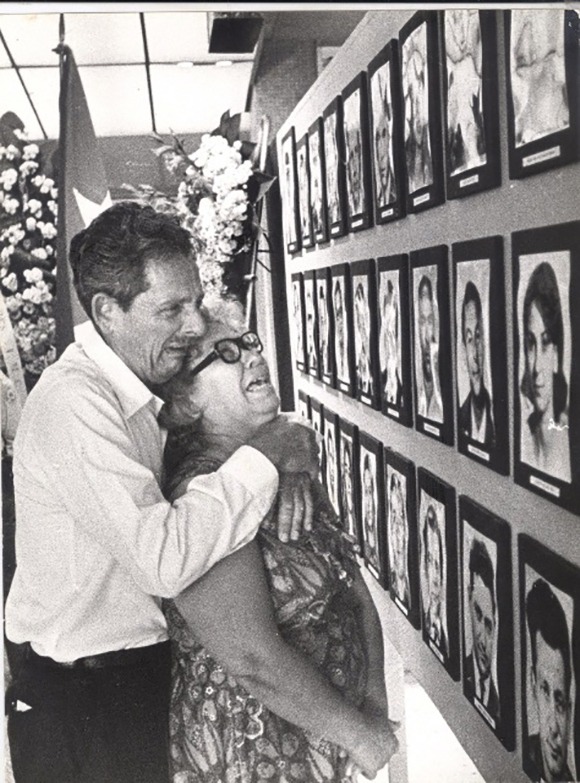For Cubans born in the 1980s, the horrendous crime in Barbados remains an open wound that pierces our memories. Since we were children, we watched on television fragments of that memorable and moving speech by our Commander in Chief, as he bid farewell to the victims of that horrendous attack that occurred on October 6, 1976.
Those images of pain—the faces of mothers fainting over photographs of their children, the members of the national fencing team gallantly accompanying, like true musketeers, their teammates from the youth team as they returned triumphantly from the Central American tournament in Caracas—remained etched in the collective memory.
And also that phrase that became recurrent and eternal for the Cuban people: Fidel, in Havana’s historic Plaza de la Revolución, before an outraged population, forcefully pronounced: “When an energetic and virile people cry, injustice trembles.”
Many years later, when asked about his daughter, José María Uranga—father of the fencer Nancy Uranga Romagoza—barely stammered.
“Today, just like the first day, I always remember her. I, the woman… But what are we going to do? Twenty or thirty years of putting flowers on her…”
Then she slowly leaned back in her seat, as if seeking refuge in the emptiness of suffering, if that emptiness ever ends. Because there are pains that don’t dissipate, that become eternal, and only abandon the person—perhaps—on the day they depart from this world.
How can we understand that human misery is enough to blow up a plane in mid-flight, with 73 people on board, including 24 teenagers and a girl?
Haymel Espinosa is one of the many children who were orphaned that October 6, 1976. Her father, Miguel Espinosa Cabrera, was the co-pilot of the Cubana flight. As she recounts in the documentary Explosión a bordo (Explosion on Board), she mourned him more during her childhood but missed him and needed him much more as an adult.
“I needed him by my side so many times, I wanted him close so many times. I wanted him with me the day I got married. I feel like that photo is unfinished: I’m with my mother, but my father is missing. I thought there was no better time to honor him than on my wedding day, and I placed flowers where the photos of the Barbados martyrs were. I dedicated them to them, especially to my dad…
When they take him away from you like that, so suddenly, you’re left with the hope that he might return. For me, it’s a dream, and it’s what I always dream about my dad. Sometimes I think I’ll meet him again, that maybe he was a shipwreck.”
Terrorism as Politics: Impunity and Protection in the United States
The terrorism incubated within sectors of the Cuban emigration has, from its origins, constituted a case of domestic terrorism on US soil. It has affected that country’s national security and damaged its public and private interests. Airlines have been threatened, victims have been victims of bomb attacks, and material damage has been considerable. However, the political will of successive US administrations, focused on destroying the Cuban political system, has allowed this phenomenon to persist to the present.
One of its exponents, Orlando Bosch, an international criminal and one of the masterminds of the sabotage of the Cubana airliner, was pardoned by President George H. W. Bush, who welcomed him as a “good man,” in open contradiction to the views of his own administration’s State and Justice Departments.
The other perpetrator, Luis Posada Carriles, a CIA agent since March 1963, carried out dozens of missions for that agency and died unpunished in Miami, without answering for his crimes.
In June 1976, representatives of extremist organizations of Cuban origin based in the United States met in Bonao, Dominican Republic. The meeting was coordinated by the aforementioned Orlando Bosch, then a fugitive from US justice for violating his parole after being tried for several crimes, including extorting Cuban emigrants through terrorist means.
The objective was to coordinate future actions against Cuban diplomatic missions, their personnel, and the interests of countries that, despite pressure, maintained relations with Cuba. Two meetings were held: one to establish the terrorist alliance known as the Coordination of United Revolutionary Organizations (CORU), and another to plan more than twenty acts of terror to be carried out immediately.
All those present signed, except for members of the fascist group Cuban Nationalist Movement (MNC), who claimed to be involved in an action ordered by the Chilean National Intelligence Directorate (DINA). That action, as was later learned, was the assassination of the former Chilean ambassador to Washington, Orlando Letelier del Solar, perpetrated on September 21, 1976, by a terrorist of Cuban origin.
The Irrefutable Evidence: Documents and Confessions
The opinion issued by Joe D. Whitley, Associate Attorney General in the process of admitting Orlando Bosch to the United States, dated January 23, 1989, supports his involvement in the attack on the Cubana de Aviación airliner.
It concludes:
“Bosch, while outside the United States, founded and directed the Coordination of United Revolutionary Organizations (CORU), an anti-Castro terrorist organization that claimed responsibility for numerous explosions in Miami, New York, Venezuela, Panama, Mexico, Argentina, and elsewhere.”
The official ruling continues:
“In October 1976, Bosch was arrested in Venezuela in connection with the explosion of a Cuban civilian airliner on October 6, 1976, which resulted in the deaths of 73 men, women, and children. Although he remained detained in Venezuela for eleven years on charges stemming from that incident, he was eventually released. Evidence was presented at his trial that the two men convicted of homicide in connection with the explosion were in contact with Bosch before and after the incident.”
The document adds:
“Following his release on May 17, 1988, Bosch was detained by the Immigration and Naturalization Service (INS). At that time, the director of the INS Miami District issued him a temporary exclusion notice, alleging that he was excludable from the United States because: ‘There is reason to believe that he would seek entry into the United States solely, primarily or incidentally, to engage in activities prejudicial to the public interest.’”
This ruling, issued by a US judicial authority, constitutes official proof of Bosch’s involvement in terrorist activities and reveals the contradictions between the judicial bodies and the political decisions that allowed him to remain in US territory.
The notice further stated: “That he is or has been an alien who advocates, teaches, or has been a member of an organization that promotes the need or desirability of attacking or assassinating officials of any government, or of injuring or destroying property, or that practices sabotage.”
The authorities concluded: “There are reasonable grounds to believe that, after entering the country, he would probably engage in activities prohibited by the laws of the United States, related to espionage, sabotage, public disorder, or other subversive actions against the national interest.”
The notice also indicated that Bosch was excludable because he had been convicted of “a crime of moral turpitude, rather than a simple political crime.”
What happened next? The offender was pardoned by the aforementioned president, who — as reported — was director of the CIA at the time of the plane explosion.
It is now known that the Cuban-born international terrorist Pablo Gustavo Castillo Díaz, alias El Cojo, one of the perpetrators of the murder of Cuban technician Artaigñán Díaz Díaz in Mexico on July 23, 1976, was the one who studied Cuban air routes in the Caribbean and selected the aircraft that would later be crashed.
On October 11, 1976, when Orlando Bosch was arrested in Caracas, he was accompanied by the aforementioned Castillo, who declared that he had prepared the bombs that were placed on the plane by Venezuelan mercenaries Freddy Lugo and Hernán Ricardo Lozano.
The CIA: Advance Knowledge and Criminal Complicity
The ever-present CIA incriminates itself in its own declassified secret documents, which demonstrate its advance knowledge of the plans to down the Cuban plane, without having done anything to prevent it. They did not even issue a timely alert to the Cuban authorities.
A declassified secret CIA document, dated October 13, 1976, under the reference “Plot No. 7514,” identified the source as “a former Venezuelan government official, usually a reliable informant,” and warned: “This information should not be discussed with any foreign official, including those of the Venezuelan government.”
The text about the downing plan stated: “Bosch made the statement: ‘Now that our organization has emerged from Letelier’s work in good standing, we’re going to try something else.’” The report added: “A few days later, at a fundraising luncheon, Posada was overheard saying, ‘We’re going to attack a Cuban airliner,’ and ‘Orlando has the details.’”
But the CIA’s foreknowledge didn’t start there. On June 22, 1976, the agency had already received information about plans to plant explosives on Cubana de Aviación flights. This is revealed by another classified document, distributed that same day, which stated: “Class Secret, Sensitive Report, Intelligence Sources and Methods Involved. Do not disclose to foreign nationals. Not for distribution to contractors or contracted consultants.”
The report detailed: “A businessman with close ties to the Cuban exile community, usually a reliable informant, revealed that an extremist group of Cuban exiles, led by Orlando Bosch, was planning to plant a bomb on a Cubana de Aviación flight between Panama and Havana. The original plans called for placing two bombs on flight 467, scheduled to depart Panama on June 21, 1976, at 11:15 a.m. local time.”
With these precise details, the CIA had the opportunity to prevent the disaster. But it chose silence. Hatred prevailed.
Copies of the revealing document were sent to the State Department, the Army Intelligence Directorate, the Army, the Navy, the Air Force, the FBI, and the CIA itself. However, the Cuban government was not informed, even though the contents specified that two bombs would be planted—as was actually the case in Barbados—identified the criminal Orlando Bosch as one of the masterminds of the attack, and designated a civilian plane belonging to Cubana de Aviación as the target. All of this was known to the CIA four months before October 6, 1976, when 73 people lost their lives, including 57 Cuban citizens.
In Cuba, October 6 has been officially declared the Day of the Victims of State Terrorism. The date was chosen precisely to honor the memory of the victims of the attack on the Cubana airliner, whose perpetrators had proven ties to the CIA.
[ SOURCE: CUBA DEBATE ]

